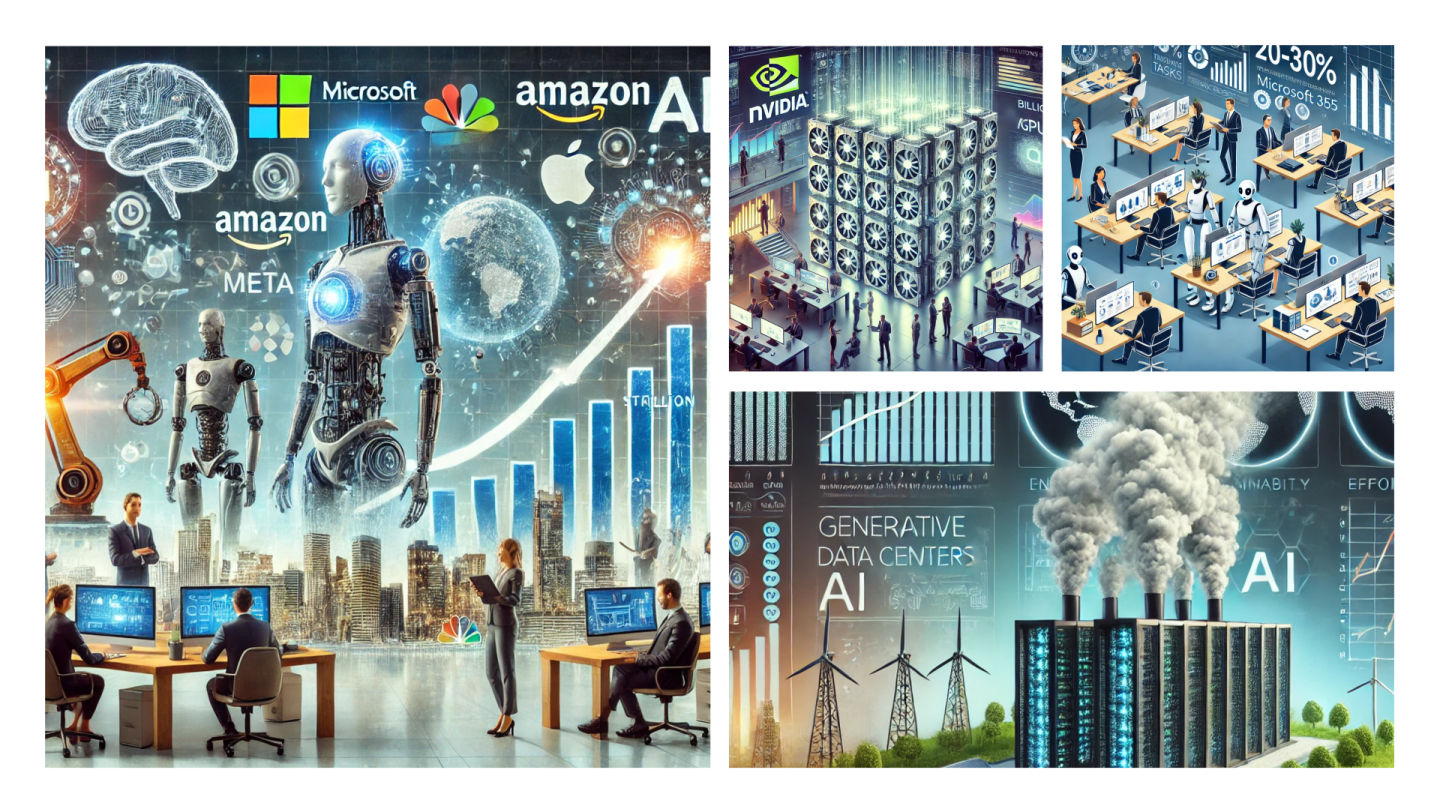The Generative AI Corporate Market in 2024
Published September 25, 2024
- Data & AI

An overview of the Generative AI market
A frenzied race for innovation, fuelled by billions
The sums invested by players in the generative AI market are primarily focused on two dimensions: research and development (R&D) and infrastructure. Microsoft, for example, has invested more than $10 billion in OpenAI since 2019 to maintain its lead in the field of large language models (LLMs) like GPT-4, now integrated into Microsoft 365 via Copilot. Google, for its part, continues to develop its own Gemini model while exploring collaborations with companies such as Anthropic.
Infrastructure, particularly the acquisition of GPUs (Graphics Processing Units), remains a central issue as the backbone of LLMs. NVIDIA, the undisputed leader in the GPU market, saw its market capitalization surpass $1 trillion in 2023, driven by an exponential demand for AI-dedicated hardware from market-shaping actors.
Diversifying language models and strategic partnerships to address go-to-market challenges
While large language models such as GPT-4.5 or Claude 3 continue to dominate the market, notable diversification is underway. Specialized models, designed for specific tasks, are gaining popularity. For instance, Google has launched lighter versions of its Gemini models, more suited to the particular needs of certain industries, thereby making these technologies more accessible to mid-sized companies. Additionally, actors like Meta are exploring models focused on social and interactive functions, while other companies are concentrating on applications in healthcare, finance, and education.
The market is also animated by a proliferation of strategic partnerships. Microsoft and Apple are working closely with OpenAI to integrate AI into their respective ecosystems, thereby optimizing the performance and capabilities of their platforms. Furthermore, Google and Amazon have strengthened their alliances with Anthropic, a promising startup. These partnerships not only accelerate innovation but also create more targeted solutions capable of meeting the varied needs of businesses, governments, and end users. Lastly, cross-sector collaborations are emerging, where traditional companies partner with AI leaders to develop applications that transform entire industries such as automotive, logistics, and media.
A bubble ready to burst?
However, this race for innovation is not without risk, and analysts are beginning to mention the possibility of an AI bubble. The potential slowdown in GPU demand, early signs of market saturation, and growing doubts about the long-term profitability of these technologies raise the specter of a brutal correction. The stagnation or slight decline of NVIDIA’s stock in August 2024, despite an announcement of better-than-expected results, supports this notion.

Three letters that crystalize the future of AI in enterprises: ROI
The acronym ‘ROI‘ (Return on Investment) has become the watchword for generative AI in companies. While in 2023 and early 2024, the fear of missing the technological shift (the famous ‘FOMO’) led many companies to hastily adopt generative AI, this September return marks a return to reason. Now, business leaders, aware of the massive investments these technologies entail, are focusing on finding use cases that offer tangible and justifiable ROI.
Individual productivity and task automation: no more debate!
One of the sectors where generative AI holds the most promise to date is improving employee productivity. In the French market, giants like TotalEnergies, Danone, and Amadeus have begun to deploy tools like Copilot for M365 on a large scale. These tools, which integrate into daily workflows, save valuable time by automating repetitive tasks, assisting in drafting documents or emails or providing summaries of complex information. According to McKinsey, companies using these tools could increase employee productivity by 20 to 30% by 2025.
This productivity gain translates into time freed up so that teams can reinvest in strategic activities, thereby increasing the achievement of their ambitions and objectives. For example, in the Human Resources department, generative AI allows the automation of drafting job descriptions or summarizing recruitment pathways, which not only reduces operational costs but also improves the quality of processes, creating a double benefit for the company.
In conclusion, despite the non-negligible cost of the solution, we do observe a positive ROI: by transitivity.
Generative AI at the core of businesses: securing ROI
Beyond productivity gains, generative AI is attempting to penetrate the core business processes of companies. These applications, often explored through proof of concepts (PoCs), must imperatively demonstrate convincing ROI to be deployed on a larger scale.
However, beautiful success stories are beginning to emerge. A global company specializing in waste management used generative AI to optimize the detection and automatic sorting of bottles in its recycling centers: the AI generated millions of images of bottles compressed in different ways, then integrated into the sorting algorithm, significantly increasing the detection rate. Similarly, an international car manufacturer uses generative AI to automatically translate its user manuals, achieving colossal savings in translation costs.
However, these projects must overcome several obstacles.
The risks associated with generative AI ‘hallucinations‘ manifest in various domains, compromising the envisaged ROI. In medicine, erroneous diagnoses generated by AI could endanger patients and expose institutions to legal risks. Similarly, in automated content writing, incorrect information could damage the company’s credibility and require costly corrections.
Other factors can negatively impact ROI: high implementation and maintenance costs, ethical or legal problems related to inappropriate content, dependency on data quality, complexity of integration with existing systems, user resistance to adopting the technology, as well as challenges related to data security and lack of transparency of models. Each of these aspects can compromise efficiency and expected benefits, making rigorous management of these risks crucial to maximizing ROI.
Beyond ROI: an ecological and social challenge
While generative AI can be a source of profitability for companies, it remains at the heart of debates on the ecological and social issues it raises.

Generative AI and the environmental challenge
The rise of these technologies is largely based on energy-intensive infrastructures, essential for training models such as GPT or Gemini. For instance, in 2023, Google saw its greenhouse gas emissions reach 14.3 million tons of CO2, an increase of 48% compared to 2019, its reference year. In its latest environmental report, the online search giant stated, “As we integrate AI into our products, reducing emissions could prove difficult.”
Faced with this reality, companies are confronted with an imperative requirement: reconcile technological innovation and environmental responsibility. This tension is even stronger for companies keen on adhering to strict environmental charters, imposed both internally and by their clients and partners. The adoption of generative AI no longer boils down to a simple ROI calculation: it engages companies in a broader approach, where technological performance and sustainability must coexist harmoniously. Clients, increasingly aware of environmental issues, now demand concrete proof of sustainable commitments. In response, some companies prioritize providers capable of demonstrating a significantly reduced ecological footprint, whether through the use of eco-friendly data centers or the development of models optimized for lower energy consumption.
Generative AI and the future of work: between opportunities and threats
On the social front, the rise of automation through generative AI raises questions about the future of work. While these technologies optimize certain processes, they also risk making a large number of jobs obsolete, exacerbating the risks of job insecurity. For example, data entry jobs, traditionally occupied by low-skilled workers, are now highly threatened by automation. Similarly, conversational AIs gradually replace agents in call centers, reducing demand for this type of job. Finally, in the financial sector, generative AI is beginning to automate complex tasks such as financial analysis or accounting management.
However, this transition to widespread automation can only truly occur if generative AIs manage to achieve a performance level equivalent to or superior to that of humans. Trust in these technologies is crucial: if automated work is not as reliable, precise, or creative as that performed by humans, the acceptance of AI by companies and the general public will remain limited. This is why human supervision remains essential to date. Employees must be trained to work alongside AI, adjusting and supervising the quality of generated deliverables. Finally, it is imperative to ensure that these AI systems operate transparently and ethically, without biases or errors that could have serious consequences.
Facing these challenges, it is crucial that the transition to automation is managed responsibly. Continuous training and professional retraining must be absolute priorities to avoid tensions within companies and growing distrust among employees towards technologies perceived as dehumanizing. Ignoring these social and ethical dimensions would risk creating a more unequal and fragmented society, where the benefits of automation would not be equitably distributed.
Conclusion
In conclusion, while the productivity gains and innovation potential of generative AI are now undeniable, they come with considerable challenges to be sustainably integrated into business strategies. The key to success lies in a balanced approach where economic performance must be aligned with technological performance, ethical practices, and ecological and socially responsible actions. Only companies capable of mastering this complexity can truly leverage generative AI in a sustainable and enduring manner.
-

Julien Floch
Associate Partner – France, Paris
Wavestone
LinkedIn